How to Spot Fake Jordans In Nairobi
Written by: Bradley K.
Read time: min read
One of my favorite pastimes when shopping for sneakers in Nairobi is looking out for the closest approximation to the real thing that I can find, especially Air Jordans. But, as it turns out, making good fake Air Jordans isn't the easiest thing in the world, and you can often tell whether a pair is real or fake by feeling them or looking for a few telltale signs of trickery.
Throughout this guide, keep in mind that Nike is one of the the most counterfeited brands in the world, and since the Jordan brand is one of their leading partners, Air Jordans are some of the most faked shoes on the planet. That would be all well and good if we didn't live in what is literally one of the counterfeiting capitals in the world - Nairobi.
Normally, all the relatively good fakes - the ones you can barely tell apart from, and often cost just as much as the real thing get shipped to developed countries. These ones are usually so good some people might not mind showing off in them (not you though, you're cool). In the general absence of genuine shoes in Nairobi, the rest of us either have to contend with Air Jordans so fake, so terrible you feel for anyone ignorant enough to buy them.
In line with its reputation, Nairobi is probably 60% fakes (don't quote me on that, it's from personal experience). Over the years, I've bumped into a few sneakers so good you can barely tell them from the original save for a few quirky quirks. Those, I inevitably end up buying because they are a valuable specimen. You'll see a few of those side-by-side their original companions throughout this article.
You guys are in luck for two reasons:
- Air Jordans are surprisingly hard to fake. It often comes down to something as mind-bogglingly obvious as the font used on the shoe or a weird-looking Jordan logo.
- You've got this guide.
With that combination, nothing could possibly go wrong?
Is another guide really necessary?
If you Google the phrase 'fake jordans', you'll probably come up with a million different results (and I'm not even joking)
 (Screenshot)
(Screenshot)
This guide is a little different from most of those articles. Unlike most developed countries where you can walk into a store or make an order online and be sure you'll get the real deal, we folks in Kenya and the rest of the developing world can't afford such luxuries. Even if we could, when is the last time you saw a Nike store selling sneakers in Nairobi?
The best bet we've got is imported shoes (ie. mitumba) and various online sneaker shops. The problem with many of these is the fact that they don't come with a box (a crucial component in telling fake vs real air jordans) and you often don't have the time to get your head together to make a Google search before buying a pair of sneakers you've randomly run into on the street. Unless you know the model and the colorways that model comes with, you're straight out of luck.
In short, this article is aimed at sneakerheads (and other shoe enthusiasts) in Nairobi, but the advice contained within it is solid enough to apply to anyone in the world. (Shoes don't become fake once they get here. If they're fake in Denmark, they're also fake in Nairobi). It will just be missing conventional advice that you're probably used to like calling the store or checking the box for a style number.
Why are counterfeits a problem?
First things first, we have to agree that counterfeit goods are a problem. You probably don't care about the fact that it costs developed economies $600 billion every year or that large companies can lose as much as $470 million in sales because they can probably afford to lose at least that much without going under. A lot of people don't care for anything other than looking good. As long as it costs significantly cheaper than the original thing and still looks good, they'll be more than glad. But there's a lot more to it than that.
Let's forget the fact that counterfeiting was so bad that in 2019, Nike stopped selling its shoes to Amazon, and give ourselves a little attention. All these billion-dollar industries are supposedly losing out on a lot of money because some university kids wanted to rock the latest Jordans without having to sell a liver. So, what impact do counterfeit products have on you - the consumer?
Why you shouldn't buy fake sneakers (or fake anything, to be honest).
This seems like a bit of a weird thing to cover, considering this is a sneaker enthusiast blog, but surely there have to be people out there genuinely curious what the big deal is with having original brand names.
Being against fake sneakers comes down to a few crucial points:
- Quality
- Durability
- Pride
Quality
In the world of counterfeits and fakes, there are two kinds of products you'll come across, depending on where you look: fakes and replicas.
Fakes are just what you probably expect - downright fakes. These are usually so bad that it takes little more than a glance to know they aren't the real deal.
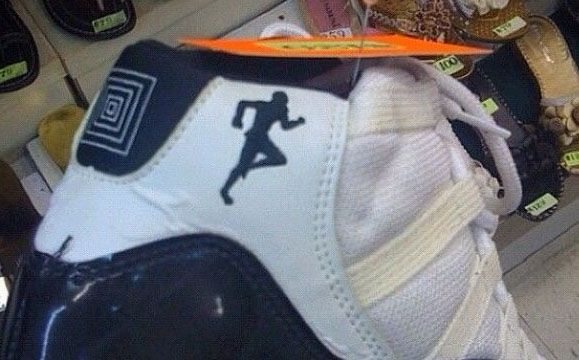
Others try harder, but still aren't able to make the cut:
 (Not too hard, but I can still see someone falling for it)
(Not too hard, but I can still see someone falling for it)
You probably don't want to be walking around in a pair of Jordans with an asscrack (think of the potential roasts to come out of that!), so that's some good motivation to start with.
Replicas are a whole other board game. Think of them as fakes made for rich people.
Durability
Quality has a direct impact on durability as well. I don't want to spend too much time on it at this point because it's covered later on in the article.
Pride
There's something magical about being the owner of a pair of shoes you know are original. A lot of folks tend to think that the whole point of sneakers is to show off to others - but that's not really it. Sure, there are a lot of people out there who live for the clout, but looking good and taking care of yourself are all about, well, yourself. If you enjoy having great shoes, you should be doing it for yourself, not because you want others to think you're rich or cool.
I don't know about you, but for me, wearing shoes I know are fake kills my confidence, not make it better.
How to Spot Fake Jordans
Before we get started, it is very important to note that the production process is never perfect. Imperfections will happen regardless of whether manufacturing is done by hand somewhere in a Chinese factory or by the most intricate machines inside the US.
In other words, even original shoes can have some form of imperfections. As long as they aren't too glaring, if your gut tells you a pair of shoes is authentic, you'd best listen.
Additionally, this doesn't serve as a universal guide. Different Jordan models miss features clearly present in others. For instance, the Jordan 1 lineup doesn't have the Jordan logo anywhere on the shoe.
Look at the Jumpman logo for imperfections
By far the easiest way to tell a real pair of Jordans from an obviously fake one is the logo. From experience, that famous Jordan logo is seriously hard to get right. You need to have the right equipment, a good amount of time on your hands and some serious talent.
This is the beginning of the Jumpman logo. Don't ask (it's a long story)
 Michael Jordan photograph featured in LIFE Magazine 1984 Olympics Special Issue, shot by Jacobus Rentmeester
Michael Jordan photograph featured in LIFE Magazine 1984 Olympics Special Issue, shot by Jacobus Rentmeester
Which would go on to inspire a more familiar rendition
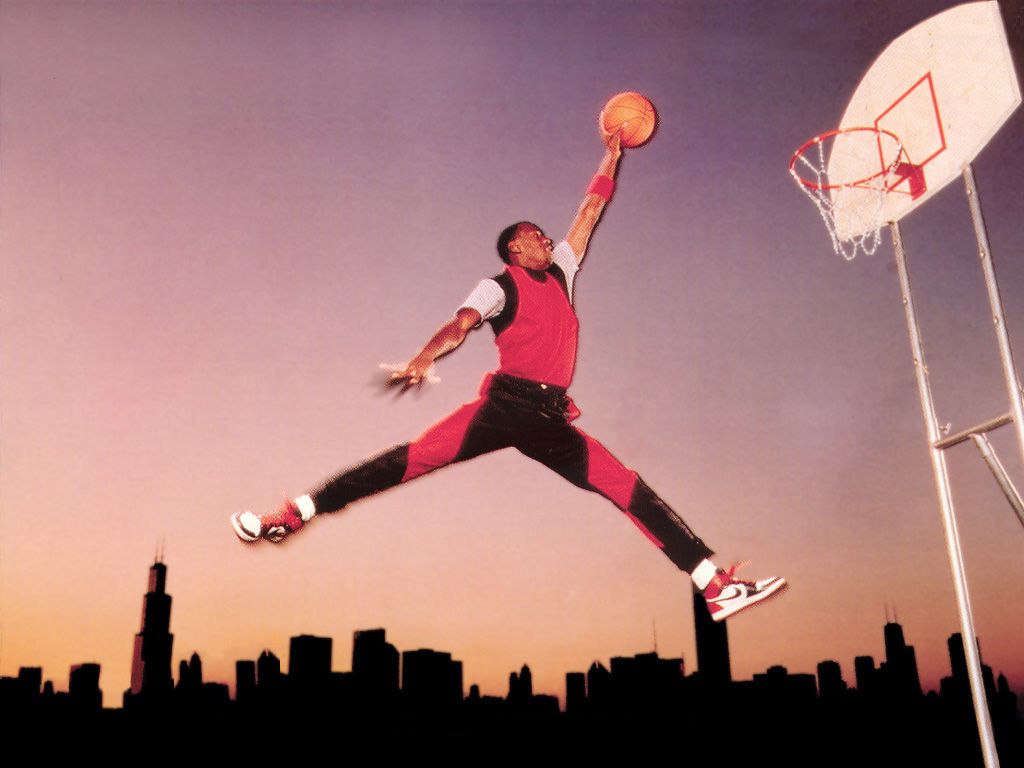 Michael Jordan doing the Jumpman pose for Nike Air Jordan 1 photoshoot (1985)
Michael Jordan doing the Jumpman pose for Nike Air Jordan 1 photoshoot (1985)
And would finally evolve into something we all know and love today
 The Jumpman logo (Courtesy of Wikipedia)
The Jumpman logo (Courtesy of Wikipedia)
This logo is super duper important. You need to study this logo until you understand literally every detail on it. Pretty simple, right? Well, not exactly.
The Jumpman logo may just be a silhouette but it's detailed enough to give people a lot of problems. Take in every detail this image has to offer - notice the shoes? Notice the creases on the outline? Notice how you can tell where the pants begin and where they end? Notice how slightly bent his back? Notice the chest definition and how you can tell he's holding the ball, not absorbing it?
All these details are so difficult to capture that not even Nike themselves can get it right every. single. time. Take a look at these Air Jordans as worn by MJ himself against the Knicks during a game in '95.
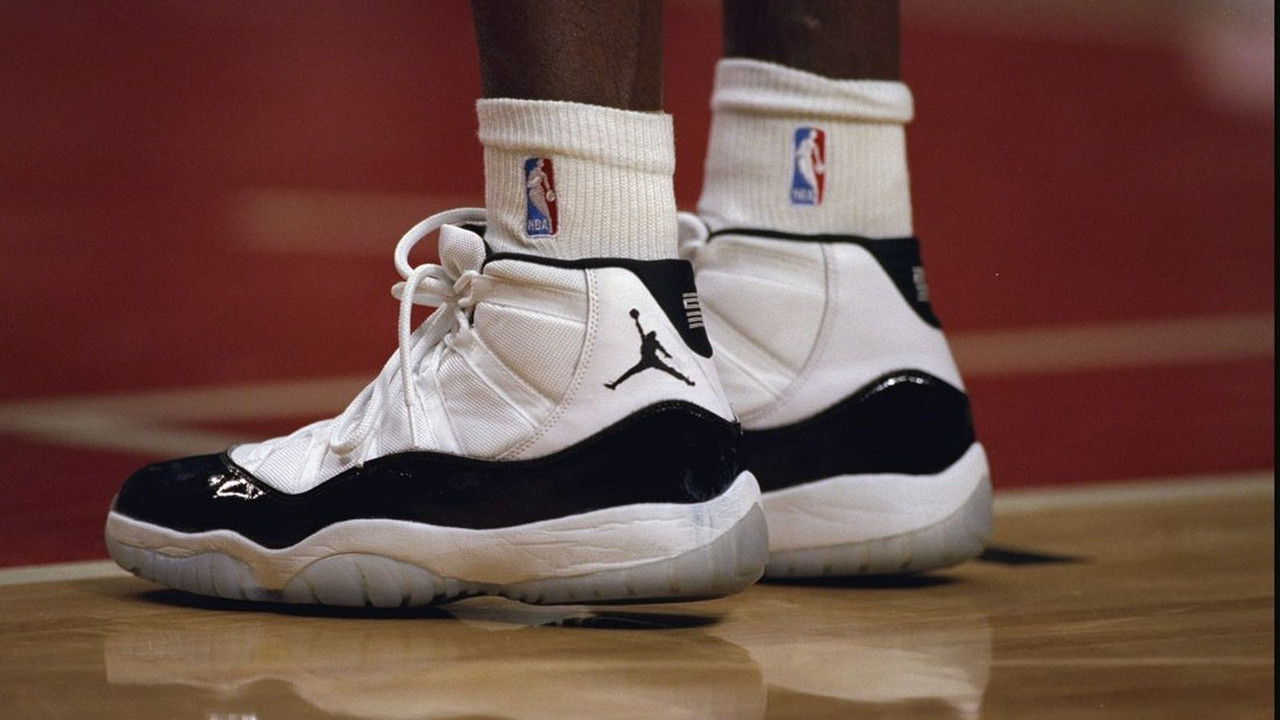 (A close-up shot of Air Jordans as they appear on the court during the game between the New York Knicks and the Chicago Bulls at the United Center in Chicago, Illinois), Getty Images
(A close-up shot of Air Jordans as they appear on the court during the game between the New York Knicks and the Chicago Bulls at the United Center in Chicago, Illinois), Getty Images
Of course, production technology has come a long way today, but even then, there's still enough detail visible on the logo that there's no doubt about their authenticity (aside from the fact that Michael Jordan is wearing them, of course).
But I digress.
Here is a fine example of a well-done pair of replicas:
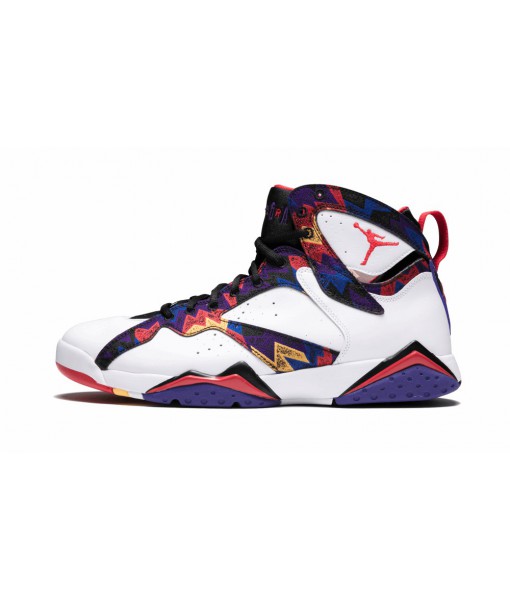
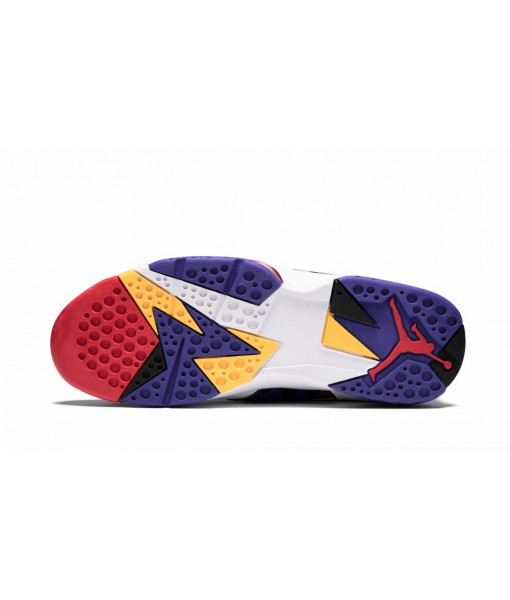
It shouldn't be immediately obvious unless you have a keen eye, but take a look at that logo and compare it with the original. Go ahead and take a minute.
Then let's look at a genuine pair of Air Jordan 7 Retros (different colorways, though)
 Jordan 7 Retro Hare (Courtesy of StockX)
Jordan 7 Retro Hare (Courtesy of StockX)
Do you see it?
The first clue is Jumpman's shoes. A particular detail that's almost always included in the tongue. In the replicas, the tongue is missing (making the shoes almost completely smooth on both sides. This is corrected in the original pair).
It's impossible to go over every little detail to do with the logo, but close inspection and a little experience will go a long way.
But since not even Nike themselves can get the logo right every time, there are luckily other ways to make sure your Jordans are real, even if you bought from Nike themselves and they still ended up with a butt crack.
It happens, a lot :point_down:
Here is your detailed look at the Gamma Blue Air Jordan 11 release on Saturday. More here. http://t.co/YOU1P8jTpi pic.twitter.com/c4SEznGTds
— Footaction (@Footaction) December 18, 2013
The Jordan logo isn't a teller of all truths
Here's an interesting one for you.
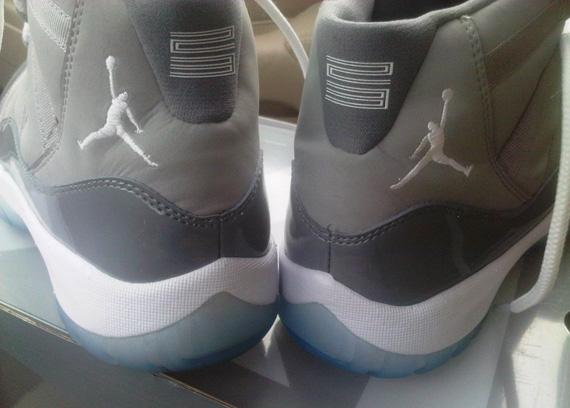 Air Jordan XI 'Cool Grey' Retro 2010 (Courtesy of Sneakernews)
Air Jordan XI 'Cool Grey' Retro 2010 (Courtesy of Sneakernews)
These are an original pair of 2010 Air Jordans, but there's only one problem: the Jordan logo is facing the wrong way.
As reported by Sneakernews, these shoes were bought early by a collector, but he wasn't sure about their authenticity because of the glaring quality control issues.
Here they are side-by-side different colorways
 Side-by-side comparison of different Jordan Colorways (Courtesy of Sneakernews)
Side-by-side comparison of different Jordan Colorways (Courtesy of Sneakernews)
Always check where he's facing. It's always the same for specific models.
But since the logo isn't as an amazing teller of truths as many would have you believe, it's worth your time going over a few more details counterfeiters have a hard time getting right.
Check the shoe construction
Here, things start to get a little more interesting. You can't always rely on the Jumpman logo alone because of production defects and all that. However, the shoe construction will always be the same in similar models.
When we talk about 'shoe construction' it refers to several things:
Fake Air Jordans use substandard materials
To tell the shoe's materials, you need to have physical contact with it, of course. the e-commerce market hasn't had as much time to penetrate the market in Nairobi as it has in a lot of the developing world, so here, we're in luck, sort of.
It'll need a bit of experience to tell, but fake air jordans are almost always built from really terrible materials. Most Jordans are made from high-quality faux leather which feels a certain way. It's pretty hard to describe, so you might have to do a bit of adventuring while checking out Jordan shoes price in Kenya to really tell.
Real vs fake jordans are often too light
An interesting consequence of using those substandard materials is that fake shoes usually feel too light. Again, it's pretty difficult to describe what 'too light' means, but here's where your gut instinct has to kick in. Do they feel or look like shoes that will fall apart within a few days of wear and tear? In that case, they are probably as fake as it gets.
Spot fake air jordans with through the tongue
The tongue. Not enough can be said about how important the tongue is when verifying real vs fake Jordans.
 Tongue of Air Force Ones I Bought in Nairobi
Tongue of Air Force Ones I Bought in Nairobi
Everything is wrong with this tongue.
- The text is too faded.
- They used the wrong font.
- The stitching below the tongue is terrible quality.
- And worst of all, take a look at this:
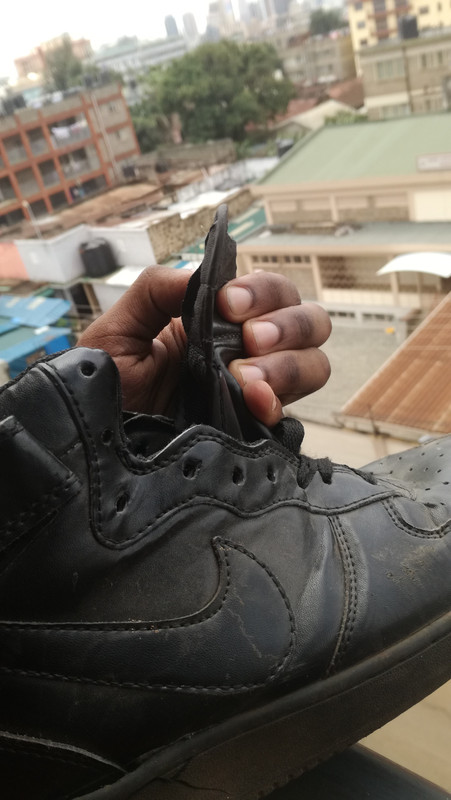 Tongue of Air Force Ones I Bought in Nairobi
PS: Don't ask why the shoes are so battered. It's a long story.
Tongue of Air Force Ones I Bought in Nairobi
PS: Don't ask why the shoes are so battered. It's a long story.
That tongue is so thin it has no right being anywhere near a pair of shoes, let alone a pair of Air Force Ones (not Jordans, but it gets the point across in either case).
There is a lot more to the tongue, though. From misplaced and missing logos, wrong fonts, misspellings and what have you. For the sake of making this article a bit easier to skim through, I'll cover that in a future article instead.
Let's compare them with some of the best shoes I've ever bought, a pair of Nike Court Force.
 Tongue of Nike Court Force I Bought in Nairobi
Tongue of Nike Court Force I Bought in Nairobi
Not a one-to-one comparison, sadly, but the amount of detail that went into them as compared to the fake Air Force Ones should be immediately obvious.
Terrible spelling
This should be an obvious one. Any kind of spelling mistake whatsoever is an immediate red flag. Run for the hills.
Awful stitching
Wrong spacing between letters
How to be safe
The best way of being safe is arming yourself with knowledge of what's what and having a trusted vendor.
If you're on the prowl for sneakers in Nairobi, classy rubber shoes Nairobi or just want to check out Jordan prices without the hassle of going to town yourself, have a look at the catalog of shoes we have to offer here at the2500.
We have everything from Jordans to Nikes to Yeezys - mitumba (refurbished) and brand new from abroad. If you're in doubt, we provide images of the original products from different angles so you can assess its quality, age and more specific details yourself.
If you're still dissatisfied with an order after it's been delivered, returns are free. No questions asked.
A lot of them are only stocked once so be on the lookout or subscribe to our newsletter. We'll let you know if we find something we think you'll like!
Copyright © 2022 Retrobie LTD